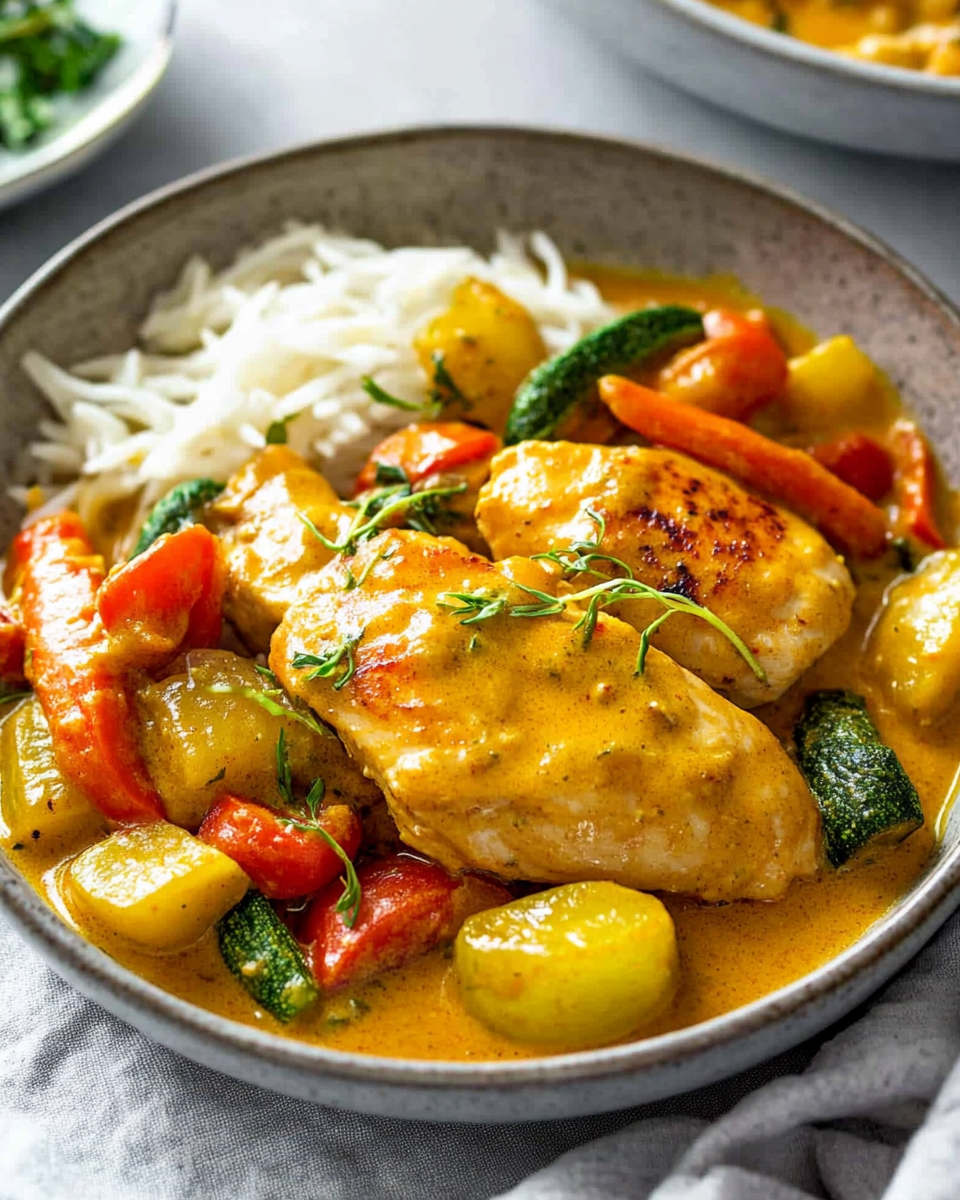This Coconut Curry Chicken with Veggies is a vibrant and flavorful dish combining tender chicken, fresh vegetables, and creamy coconut milk infused with fragrant curry spices. It’s a wholesome, comforting meal perfect for a quick weeknight dinner or a satisfying lunch.
FULL RECIPE
Ingredients
- 1 lb (450g) boneless, skinless chicken breast, cut into bite-sized pieces
- 1 tbsp vegetable oil
- 1 small onion, finely chopped
- 2 cloves garlic, minced
- 1 tbsp fresh ginger, grated
- 2 tbsp red curry paste
- 1 can (14 oz/400 ml) coconut milk
- 1 red bell pepper, sliced
- 1 cup snap peas or green beans
- 1 medium carrot, thinly sliced
- 1 tbsp fish sauce (optional)
- 1 tsp brown sugar
- Juice of 1 lime
- Fresh cilantro or basil for garnish
- Salt and pepper to taste
- Cooked rice or naan, for serving
Directions
- Heat oil in a large skillet or wok over medium-high heat. Add chicken pieces and cook until browned and nearly cooked through, about 5-6 minutes. Remove chicken and set aside.
- In the same pan, add onion, garlic, and ginger. Sauté until fragrant and onion is soft, about 3 minutes.
- Stir in red curry paste and cook for 1 minute to release the flavors.
- Pour in coconut milk, stirring to combine with curry paste. Bring to a gentle simmer.
- Add sliced bell pepper, snap peas, and carrot. Cook until vegetables are tender but still crisp, about 4-5 minutes.
- Return chicken to the pan, stir in fish sauce and brown sugar. Simmer for another 3-4 minutes until chicken is fully cooked and flavors meld.
- Remove from heat, stir in lime juice, and season with salt and pepper to taste.
- Garnish with fresh cilantro or basil and serve hot over rice or with naan.
Nutritional Information
- Calories: 350-400 kcal
- Protein: 30g
- Fat: 22g
- Carbohydrates: 12g
- Fiber: 3g
- Sugars: 5g
- Sodium: 600mg
Flavor Profile and Aromatics
Coconut Curry Chicken with Veggies is a harmonious blend of rich, creamy coconut milk and the warm, spicy notes of red curry paste. The ginger and garlic add a fresh pungency that balances the sweetness of the coconut and the slight heat of the curry. The combination of these aromatics creates a layered depth of flavor that is both comforting and exciting to the palate.
Health Benefits of Coconut Milk
Coconut milk is a key ingredient in this recipe, offering more than just creamy texture. It contains medium-chain triglycerides (MCTs), which are easily digested fats that may boost metabolism and provide a quick energy source. Additionally, coconut milk is rich in vitamins C, E, B1, B3, B5, and B6, as well as important minerals such as iron, selenium, sodium, calcium, magnesium, and phosphorus.
Protein Power from Chicken
Chicken breast is a lean source of protein that helps build and repair muscles, making this dish ideal for those seeking a balanced meal. It is low in fat and high in essential amino acids, which are crucial for maintaining muscle mass and supporting overall bodily functions.
Vegetable Nutrition
The vegetables in this dish — bell peppers, snap peas, and carrots — contribute essential vitamins, fiber, and antioxidants. Bell peppers are rich in vitamin C and beta-carotene, while carrots provide vitamin A for eye health. Snap peas add crunch and vitamin K, supporting bone health and immune function.
Cultural Origins
This dish draws inspiration from Southeast Asian cuisine, particularly Thai culinary traditions. The use of coconut milk and curry paste is a hallmark of Thai cooking, known for its balance of sweet, sour, salty, and spicy flavors. This recipe adapts those authentic tastes into an accessible home-cooked meal.
Spice Level and Customization
Red curry paste delivers moderate heat with a complex spice blend, but the spice level can be adjusted easily. For those who prefer milder flavors, reducing the curry paste or substituting with a milder yellow curry paste works well. For spice lovers, adding fresh chilies or a dash of chili flakes can amplify the heat.
Cooking Techniques
The recipe uses sautéing and simmering as primary techniques. Sautéing the aromatics like garlic, ginger, and onion helps release their essential oils, intensifying the flavor. Simmering with coconut milk and vegetables allows the ingredients to meld together gently, preserving the texture of the veggies while fully cooking the chicken.
Versatility in Vegetables
One of the strengths of this recipe is its adaptability with different vegetables. You can swap snap peas for green beans or broccoli, add zucchini or eggplant, or even include leafy greens like spinach or kale at the end of cooking. This flexibility allows you to use seasonal produce or whatever you have on hand.
Serving Suggestions
Coconut Curry Chicken pairs beautifully with steamed jasmine rice, basmati rice, or even quinoa for a healthier grain alternative. Naan bread or roti can also be served alongside to scoop up the curry sauce, making the meal more interactive and satisfying.
Meal Prep and Leftovers
This dish reheats well, making it a great option for meal prep. Store leftovers in an airtight container in the fridge for up to three days. The flavors deepen overnight, making the curry taste even better the next day. It can also be frozen for up to a month, though the texture of some vegetables may soften upon thawing.
Nutritional Considerations
Though coconut milk is higher in fat, most of these fats are healthy saturated fats beneficial for energy. The dish is high in protein and fiber, which help keep you full longer and stabilize blood sugar levels. For those watching sodium intake, it’s advisable to adjust or omit the fish sauce and use low-sodium alternatives.
Gluten-Free and Dairy-Free
This recipe is naturally gluten-free and dairy-free, catering to many dietary restrictions. It offers a wholesome alternative for those avoiding gluten or lactose without compromising flavor or texture.
Pairing with Beverages
To complement the creamy, spicy flavors, a light, crisp beverage pairs best. A chilled white wine such as Sauvignon Blanc or a light beer can balance the spice. For a non-alcoholic option, iced green tea or sparkling water with a splash of lime works wonderfully.
Use of Fresh Herbs
Finishing the dish with fresh cilantro or basil adds a bright, herbal note that contrasts the richness of the curry. These herbs also provide a fresh aroma and additional nutrients, elevating the dish both in taste and presentation.
Balancing Sweet and Savory
The addition of brown sugar or natural sweeteners balances the salty and spicy components, rounding out the flavor profile. This balance is critical in curry dishes, where too much heat can overwhelm the palate without a hint of sweetness to soften it.
Importance of Acid
Lime juice added at the end provides acidity that brightens the dish and cuts through the creaminess of the coconut milk. This contrast prevents the curry from feeling too heavy and enhances the overall complexity of flavors.
Sustainability Aspect
Using chicken breast and a variety of vegetables in a single dish encourages mindful consumption of protein and plant-based foods. This balanced approach is better for the environment compared to heavier meat-centric meals and supports sustainable eating habits.
Cooking Time and Convenience
This recipe is designed to be quick and straightforward, taking about 30 minutes from start to finish. It’s perfect for busy individuals who want a nutritious, flavorful homemade meal without spending hours in the kitchen.
Appeal to Various Diets
Due to its lean protein, vegetable content, and use of coconut milk, this recipe fits well within paleo, keto (with portion adjustments), and Whole30-type diets. Its gluten- and dairy-free nature further increases its accessibility.
Visual Appeal
The vibrant colors from red bell peppers, green snap peas, and orange carrots make this dish visually enticing. A colorful meal can enhance appetite and make dining more enjoyable, encouraging healthier eating habits.
Conclusion
Coconut Curry Chicken with Veggies is a delicious, nourishing dish that balances rich creaminess with vibrant spices and fresh vegetables. It offers versatility in ingredients, suits various dietary needs, and can be easily customized to personal taste preferences. With its quick preparation time and satisfying flavors, this recipe is a wonderful addition to any home cook’s repertoire, delivering both comfort and nutrition in every bite.






